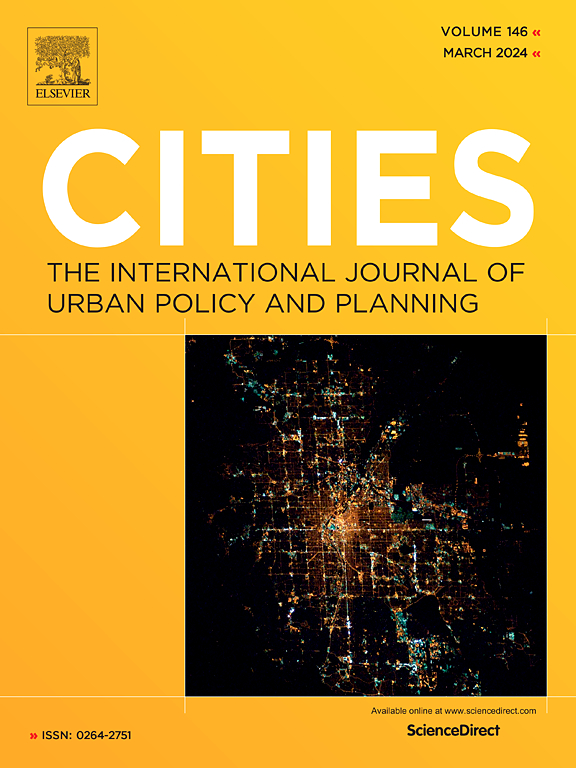非正式创意空间与儿童共同设计公共空间:来自巴西的经验
IF 6.6
1区 经济学
Q1 URBAN STUDIES
引用次数: 0
摘要
《联合国儿童权利公约》(UNCRC)第12条承认,每个儿童都有权让他们的想法在影响他们生活的公共空间的共同设计中得到倾听和应有的重视。旨在让儿童有意义地参与公共空间共同设计的倡议数量在世界范围内有所增加,研究成果也对这些实践有价值。但这些都是有限的,许多伪合作的例子仍然存在,阻碍了《公约》的维护。决定在哪里与儿童共同设计是至关重要的,因为社会生理因素会影响创造力。出于不同的合理原因,空间的物理结构被设想为支持其他活动,而不是共同设计——非正式的创意空间——被用于与孩子们一起努力(例如,游乐场)。然而,研究忽略了在这些空间中支持协同设计的环境条件。一项自底向上的反思性主题分析显示,参与儿童共同设计工作室的建筑系学生的自我报告(N = 48)显示,原型的社会规范松散(水平的儿童-成人关系)、时间间隔(被视为休息的时间块)和功能开放性(正式的模糊性)支持在非正式的创意空间中与儿童进行有意义的共同设计。提出的框架开始填补学术文献中关于非正式创意空间在促进儿童有意义地参与公共空间共同设计方面的作用的空白。研究结果为在非正式创意空间中与儿童进行有意义的共同设计的实践、研究和教学/学习的成年人提供了实用的清单。本文章由计算机程序翻译,如有差异,请以英文原文为准。

Informal creative spaces for meaningful co-design of public spaces with children: lessons from Brazil
Article 12 of the United Nations Convention on the Rights of the Child (UNCRC) recognises every child has the right to have their ideas heard and given due weight in the co-design of public spaces that affect their lives. The number of initiatives aiming for the meaningful involvement of children in the co-design of public spaces has increased worldwide, as well as research outputs valuable to inform these practices. But these remain limited, and many instances of pseudo-collaborations still exist, hindering the upholding of UNCRC. Deciding where to co-design with children is crucial because socio-physical aspects influence creativity. For different plausible reasons, spaces whose physical configurations were conceived to support other activities rather than co-design––informal creative spaces––have been used for this endeavour with children (e.g., playgrounds). Yet, studies overlooked the environmental conditions that support co-design in these spaces. A bottom-up reflexive thematic analysis of self-reports (N = 48) from architecture students who participated in a co-design studio with children revealed that social norms looseness (horizontal child-adult relationships), temporal in-betweenness (blocks of time perceived as breaks), and functional openness (formal ambiguity) of prototypes support meaningful co-design with children in informal creative spaces. The proposed framework begins to fill the gap in the academic literature on the role of informal creative spaces in facilitating the meaningful involvement of children in the co-design of public spaces. The findings informed a practical checklist for adults invested in practising, researching, and teaching/learning meaningful co-design with children in informal creative spaces.
求助全文
通过发布文献求助,成功后即可免费获取论文全文。
去求助
来源期刊

Cities
URBAN STUDIES-
CiteScore
11.20
自引率
9.00%
发文量
517
期刊介绍:
Cities offers a comprehensive range of articles on all aspects of urban policy. It provides an international and interdisciplinary platform for the exchange of ideas and information between urban planners and policy makers from national and local government, non-government organizations, academia and consultancy. The primary aims of the journal are to analyse and assess past and present urban development and management as a reflection of effective, ineffective and non-existent planning policies; and the promotion of the implementation of appropriate urban policies in both the developed and the developing world.
 求助内容:
求助内容: 应助结果提醒方式:
应助结果提醒方式:


